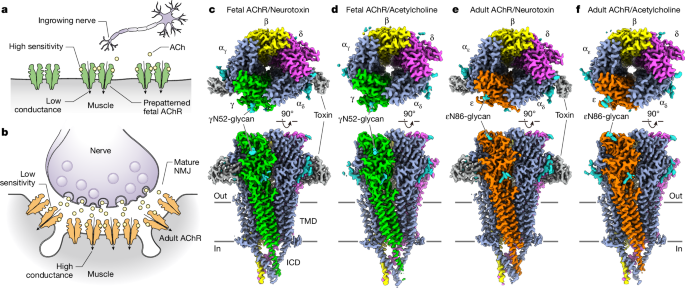approfondimento - Computational Biology - # Structural Transition of Acetylcholine Receptors in Developing Muscle
High-Resolution Structures Reveal Structural Switch in Acetylcholine Receptors During Neuromuscular Synapse Development
Concetti Chiave
High-resolution structures of fetal and adult muscle nicotinic acetylcholine receptors provide insights into the structural principles underlying the switch from fetal to adult receptor isoforms during neuromuscular synapse maturation.
Sintesi
The content discusses the structural changes in acetylcholine receptors (AChRs) during the development of neuromuscular synapses. Key points:
- Motor neurons release acetylcholine (ACh) which binds to nicotinic AChRs on muscle fibers, initiating contraction.
- Two types of AChRs are present in developing muscle cells, and their differential expression marks the maturation of neuromuscular synapses.
- The authors present high-resolution structures of both fetal and adult muscle nicotinic AChRs isolated from bovine skeletal muscle.
- These structures, obtained in the absence and presence of ACh, provide a structural context for understanding how fetal versus adult receptor isoforms are tuned for synapse development versus high-fidelity skeletal muscle contraction.
- The structural differences are driven by binding site access, channel conductance tuning via surface electrostatics, and open duration changes resulting from intrasubunit interactions and structural flexibility.
- The structures also reveal pathogenic mechanisms underlying congenital myasthenic syndromes.
Personalizza riepilogo
Riscrivi con l'IA
Genera citazioni
Traduci origine
In un'altra lingua
Genera mappa mentale
dal contenuto originale
Visita l'originale
www.nature.com
Structural switch in acetylcholine receptors in developing muscle - Nature
Statistiche
During development, motor neurons originating in the brainstem and spinal cord form elaborate synapses with skeletal muscle fibres.
Two types of AChR are present in developing muscle cells, and their differential expression serves as a hallmark of neuromuscular synapse maturation.
Citazioni
"These structures, obtained in the absence and presence of ACh, provide a structural context for understanding how fetal versus adult receptor isoforms are tuned for synapse development versus the all-or-none signalling required for high-fidelity skeletal muscle contraction."
"The structures further reveal pathogenic mechanisms underlying congenital myasthenic syndromes."
Approfondimenti chiave tratti da
by Huanhuan Li,... alle www.nature.com 07-31-2024
https://www.nature.com/articles/s41586-024-07774-6
Domande più approfondite
How do the structural differences between fetal and adult AChRs enable the transition from synapse development to high-fidelity muscle contraction?
The structural variances between fetal and adult acetylcholine receptors (AChRs) play a crucial role in facilitating the transition from synapse development to high-fidelity muscle contraction. In fetal muscle, the AChRs exhibit distinct characteristics that are tailored towards synapse maturation. These fetal AChRs have specific binding site access, channel conductance, and open duration properties that are optimized for the developmental stage of the neuromuscular synapse. As the muscle matures into adulthood, there is a structural switch in AChR isoforms to the adult type, which are finely tuned for the precise and coordinated muscle contractions required for movement. The adult AChRs have different ACh affinity, channel conductance, and open duration features compared to fetal AChRs, allowing for the all-or-none signaling essential for high-fidelity muscle contraction. Therefore, the structural differences between fetal and adult AChRs enable the transition from synapse development, characterized by maturation and plasticity, to the precise and efficient muscle contractions needed for motor function.
What are the potential therapeutic implications of understanding the structural basis of congenital myasthenic syndromes?
Understanding the structural basis of congenital myasthenic syndromes (CMS) holds significant therapeutic implications for the development of targeted treatments for individuals affected by these genetic disorders. By elucidating the structural defects in acetylcholine receptors (AChRs) associated with CMS, such as mutations affecting binding site access, channel conductance, or open duration, researchers can design specific interventions to address these abnormalities. Therapeutic strategies could involve developing drugs that modulate ACh affinity, channel conductance, or receptor stability to restore proper neuromuscular transmission in individuals with CMS. Additionally, structural insights into the pathogenic mechanisms underlying CMS can guide the design of gene therapies aimed at correcting the genetic mutations responsible for these syndromes. Overall, understanding the structural basis of CMS opens up avenues for personalized medicine approaches that target the specific molecular defects underlying these neuromuscular disorders.
What other developmental transitions in receptor structure and function could be explored using similar high-resolution structural approaches?
High-resolution structural approaches can be applied to investigate a wide range of developmental transitions in receptor structure and function beyond acetylcholine receptors (AChRs). For example, the transition from immature to mature forms of neurotransmitter receptors, such as gamma-aminobutyric acid (GABA) receptors or glutamate receptors, could be explored to understand how changes in receptor structure contribute to synaptic maturation and plasticity in the central nervous system. Additionally, studying the developmental transitions in hormone receptors, cytokine receptors, or growth factor receptors could provide insights into how structural changes modulate signaling pathways during growth, differentiation, and tissue homeostasis. Furthermore, exploring the structural dynamics of immune cell receptors during immune cell development and activation could offer valuable information on how receptor structures adapt to different stages of immune responses. Overall, applying high-resolution structural approaches to investigate various receptor systems across different biological contexts can enhance our understanding of developmental processes and pave the way for targeted therapeutic interventions in various diseases and disorders.
0
